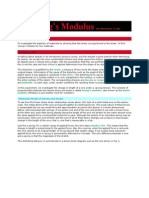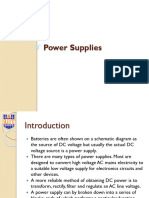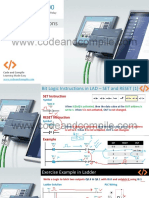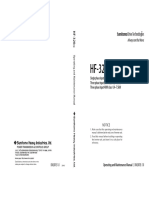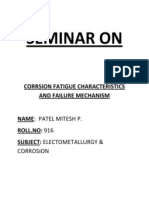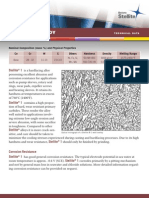0 ratings0% found this document useful (0 votes)
77 viewsIntroduc) On To Wear: Surfaces, Interfaces, and Their Applica) Ons II Nicholas D. Spencer
Introduc) On To Wear: Surfaces, Interfaces, and Their Applica) Ons II Nicholas D. Spencer
Uploaded by
Kunal PandeyThis document provides an introduction to tribology, which is the study of interacting surfaces in relative motion and the associated friction and wear processes. It defines key tribology concepts such as asperities, contact area, friction, lubrication, and wear. The summary discusses the Stribeck curve, which shows how friction varies with speed and lubrication conditions. It also summarizes Archard's wear equation, which models wear volume as proportional to load and sliding distance and inversely proportional to hardness. Different wear mechanisms like adhesive, abrasive, surface fatigue, erosive, and corrosive wear are also introduced.
Copyright:
© All Rights Reserved
Available Formats
Download as PDF, TXT or read online from Scribd
Introduc) On To Wear: Surfaces, Interfaces, and Their Applica) Ons II Nicholas D. Spencer
Introduc) On To Wear: Surfaces, Interfaces, and Their Applica) Ons II Nicholas D. Spencer
Uploaded by
Kunal Pandey0 ratings0% found this document useful (0 votes)
77 views26 pagesThis document provides an introduction to tribology, which is the study of interacting surfaces in relative motion and the associated friction and wear processes. It defines key tribology concepts such as asperities, contact area, friction, lubrication, and wear. The summary discusses the Stribeck curve, which shows how friction varies with speed and lubrication conditions. It also summarizes Archard's wear equation, which models wear volume as proportional to load and sliding distance and inversely proportional to hardness. Different wear mechanisms like adhesive, abrasive, surface fatigue, erosive, and corrosive wear are also introduced.
Original Description:
about wear of Tool steel and properties of material
Original Title
Wear Lecture
Copyright
© © All Rights Reserved
Available Formats
PDF, TXT or read online from Scribd
Share this document
Did you find this document useful?
Is this content inappropriate?
This document provides an introduction to tribology, which is the study of interacting surfaces in relative motion and the associated friction and wear processes. It defines key tribology concepts such as asperities, contact area, friction, lubrication, and wear. The summary discusses the Stribeck curve, which shows how friction varies with speed and lubrication conditions. It also summarizes Archard's wear equation, which models wear volume as proportional to load and sliding distance and inversely proportional to hardness. Different wear mechanisms like adhesive, abrasive, surface fatigue, erosive, and corrosive wear are also introduced.
Copyright:
© All Rights Reserved
Available Formats
Download as PDF, TXT or read online from Scribd
Download as pdf or txt
0 ratings0% found this document useful (0 votes)
77 views26 pagesIntroduc) On To Wear: Surfaces, Interfaces, and Their Applica) Ons II Nicholas D. Spencer
Introduc) On To Wear: Surfaces, Interfaces, and Their Applica) Ons II Nicholas D. Spencer
Uploaded by
Kunal PandeyThis document provides an introduction to tribology, which is the study of interacting surfaces in relative motion and the associated friction and wear processes. It defines key tribology concepts such as asperities, contact area, friction, lubrication, and wear. The summary discusses the Stribeck curve, which shows how friction varies with speed and lubrication conditions. It also summarizes Archard's wear equation, which models wear volume as proportional to load and sliding distance and inversely proportional to hardness. Different wear mechanisms like adhesive, abrasive, surface fatigue, erosive, and corrosive wear are also introduced.
Copyright:
© All Rights Reserved
Available Formats
Download as PDF, TXT or read online from Scribd
Download as pdf or txt
You are on page 1of 26
lnLroducuon Lo wear
Surfaces, lnLerfaces, and Lhelr
Appllcauons ll
nlcholas u. Spencer
8ecap: denluon of Lrlbology
!"#$%&%'( #* +,- *.#-/.- 0/1 +-.,/%&%'( %2 #/+-"0.3/' *4"20.-* #/ "-&035- 6%3%/ 0/1
"-&0+-1 *4$7-.+* 0/1 8"%.-**-*
8ubblng surfaces are never perfecLly aL
8oughness
1he normal load ls borne by Lhe asperlues on each
surface comlng lnLo conLacL wlLh each oLher
ConLacL areas are small (asperlues)
ressures are large
Asperlues become elasucally and plasucally
deformed upon conLacL wlLh each oLher
ConLacL areas lncrease
ConLacL pressure may evenLually exceed Lhe
elasuc llmlL of Lhe maLerlal
1rue area = apparenL area !"#$ lf surfaces are aLomlcally smooLh
%&'( *&(* ++ ,--*&(". *&(*
http://images.google.ch
8ecap: frlcuon and lubrlcauon
8eslsLance encounLered when one body ls moved over anoLher
9:;<=
0.001 (e.g. ln a lubrlcaLed bearlng under llghL loads)
10 (e.g. when clean meLals rub agalnsL each oLher ln vacuum)
0.1 - 1.0 (mosL -values for slldlng surfaces)
W = normal load
l = frlcuonal force
lrlcuon coemclenL ls dlsplayed as a funcuon of Lhe vlscoslLy muluplled by Lhe
Langenual veloclLy, and dlvlded by Lhe normal load (qu/W)
8ecap: Lhe SLrlbeck curve
ln lubrlcaLed sysLems, Lhe frlcuon coemclenL
changes as a funcuon of speed
A bearlng wanLs Lo be operaLed here!
Close Lo Lhe mlnlmum buL on Lhe rlghL
slde, so LhaL wlLh sllghL changes of Lhe
parameLers, Lhe sysLem ls drawn
Lowards Lhe mlnlmum
Film thickness decreases
Asperity-asperity
contact occurs
Cccurs aL hlgh loads or low speeds
Pydrodynamlc forces can no longer malnLaln a lubrlcanL lm beLween Lhe slldlng
surfaces
ulrecL conLacL beLween Lhe asperlues sLarLs Lo become domlnanL
8oundary lubrlcanL ls essenual under Lhese condluons, ln order Lo avold excesslve frlcuon
and wear
8oundary lubrlcanLs form adsorbed molecular lms on Lhe surfaces (overslmpllcauon)
8epulslve forces beLween Lhe
lms carry a slgnlcanL parL
of Lhe load
8ecap: boundary lubrlcauon
Lxample of boundary lubrlcanL: long-chaln carboxyllc aclds (polar end-groups make a
sLrong bond wlLh Lhe oxlde layer of meLal surfaces)
varlauon of frlcuon coemclenL as a funcuon
of Lhe lubrlcanL chaln lengLh for sLeel
surfaces
lrlcuon coemclenL as a funcuon of chaln
lengLh for hydrocarbons on LungsLen
surfaces
8ecap: boundary lubrlcauon
LxLreme-pressure addluves: molecules LhaL reacL ln exLreme condluons
(e.g. pressure, LemperaLure)
1hey reacL wlLh Lhe surface, produclng a proLecuve layer wlLh low shear sLrengLh
ln exacLly Lhe rlghL place
Some examples: zlnc
dlalkyldlLhlophosphaLe (Znu1), Lrlcresyl
phosphaLe (1C) and dlbenzyl dlsulde
SLrucLure of proLecuve lm
formed by Znu1 on sLeel
8ecap: boundary lubrlcauon
Wear
http://images.google.ch
Low frlcuon,
hlgh wear!
Plgh frlcuon,
low wear!
Whenever surfaces rub agalnsL each oLher, wear almosL always occurs
A slmple analysls ylelds a wear coemclenL k
Assumpuons
- Lhe conLacL beLween Lhe surfaces occurs aL asperlues
- Lhe Lrue conLacL area ls Lhe sum of Lhe lndlvldual asperlLy conLacLs
- Lhe Lrue conLacL area ls proporuonal Lo Lhe normal load
- Lhe local deformauon ls plasuc
Wear: Lhe Archard equauon
Schemauc dlagram of Lhe formauon of a conLacL area durlng Lhe relauve mouon of
Lwo asperlues
Wear: Lhe Archard equauon
a) b) c) d) e)
c) - Lhe conLacL area becomes maxlmal
- Lhe normal load, supporLed by conLacL area, ls glven by:
d), e) - asperlLy conLacLs supporL Lhe normal load
- conunuous slldlng lnvolves conunuous creauon and desLrucuon of slngle-
asperlLy conLacL areas
p: ow pressure (lndenLauon hardness)
a: radlus of Lhe conLacL area
2
=:8>0
Maxlmal conLacL
area
Slngle asperlLy
real area = apparenL area
AsperlLy conLacLs supporL Lhe
normal load
/!. *## *0-(&1.$ 2!".*2.0 #(*3 .! 4(*& -*&52#(066666
Wear: Lhe Archard equauon
Cause of wear: removal of fragmenLs of maLerlal from Lhe asperlues
volume of removed maLerlal: proporuonal Lo Lhe cube of Lhe conLacL dlmenslon, a
a: radlus of hemlsphere
Assumpuon: noL aLs buL hemlspheres (a hemlsphere geLs rubbed o)
Assumpuon: a proporuon k forms parucles
v: mean wear volume produced by Lhe slldlng of an
asperlLy palr over each oLher
C: LoLal wear raLe, due Lo all asperlLy conLacLs (sum of
all conLrlbuuons over Lhe LoLal conLacL area)
Wear: Lhe Archard equauon
W: LoLal normal load
C: wear raLe (worn volume per unlL slldlng dlsLance)
k = k/3 (wear coemclenL)
P = p (lndenLauon hardness)
%7( ,&27*&3 (8'*5!"
- k ls dlmenslonless and < 1
- k/P ls used when hardness ls noL easlly denable
- k/P = quanuLy of worn maLerlal/unlL slldlng dlsLance/unlL normal load (e.g. mm
3
m
-1
n
-1
)
Wear raLe ls lndependenL of
Slldlng speed
ApparenL conLacL area
Wear: Lhe Archard equauon
ln wear volume over Lhe enure slldlng dlsLance ln an unlubrlcaLed pln-on-rlng
LesL, slldlng on Lool sLeel
CharacLerlsucs of Lhe maLerlals
under sLeady-sLaLe condluons
Surfaces musL oen be run-ln"
before Lhls behavlor can be
observed
Wear: Lhe Archard equauon
values of Lhe dlmenslonless wear coemclenL k for varlous maLerlals slldlng on Lool
sLeel, obLalned ln an unlubrlcaLed pln-on-rlng LesL ln alr
9*.(&1*# :#131"; -*&."(& <(*& 2!(=21(".0> ?
mlld sLeel Mlld sLeel 7!10
-3
a/b 8rass 1ool sLeel 6!10
-4
1lL 1ool sLeel 2.3!10
-3
a 8rass 1ool sLeel 1.7!10
-4
MMA 1ool sLeel 7!10
-6
copper-berylllum 1ool sLeel 3.7!10
-3
hardened Lool sLeel 1ool sLeel 1.3!10
-4
SLelllLe 1 1ool sLeel 3.3!10
-3
sLalnless sLeel (ferrluc) 1ool sLeel 1.7!10
-3
L 1ool sLeel 1.3!10
-7
1he values are hlghly dependenL on LesL condluons and Lhus provlde llule lnslghL
lnLo Lhe wear mechanlsms lnvolved
Mlld and severe wear
Wear and elecLrlcal
conLacL reslsLance for a
pln made from "/#
brass slldlng on
hardened sLelllLe (Co
alloy) as a funcuon of
Lhe normal load
oxlde-oxlde
Pexadecane used as a
lubrlcanL, buL noL under
hydrodynamlc condluons
meLal-meLal
blgger parucles
ne slze parucles
wearlng Lhrough Lhe oxlde layer
,&27*&3
(8'*5!"
7!#30
<(*& &*.(
1"2&(*0(0
,&27*&3
(8'*5!"
7!#30
Mlld and severe wear
oxlde-oxlde
meLal-meLal
blgger parucles
ne slze parucles
ConLacL reslsLance decreases unul
meLal-meLal conLacL ls reached
@&!- 1" (#(2.&12*#
&(010.*"2(
A7*";( 1" 2!#!& *"3
01B( !C 4(*& -*&52#(0
9DE@
<F,G
:FHFGF <F,G
%
G
,
/
:
D
%
D
I
/
ulerenL color because
now meLal parucles and no
longer oxlde
Mlld wear: 0.01-1 m
parucles, mosLly oxldes
Severe wear: 20-200 m
parucles, mosLly meLalllc
Mlld and severe wear
The mechanism of the transition is confirmed by the following results
Variation of wear coefficient with sliding speed for "/# brass sliding on steel at
various temperatures and environments
1ypes of wear
Adheslve
Abraslve
Surface laugue
Lroslve
Corroslve
1ypes of wear: adheslve
Adhesion result of the direct contact of bearing metals
Applied load is sufficient to rupture any protective surface film (oxides, etc.)
Contacting asperities deform elastically
Contacting asperities deform plastically
Shearing of adhesive junctions produces wear particles
Metal is transferred from one bearing surface to the other in sliding or rolling motion
Scuffing severe adhesive-wear damage
1ypes of wear: adheslve
www.machinerylubrication.com
Process of adhesive wear
The factors decreasing adhesive wear:
Lower load
Harder rubbing materials
Contaminated rubbing surfaces
Presence of solid lubricants
Presence of a lubricating oil
Anti-wear additives in oil
1ypes of wear: abraslve
A harder maLerlal ls rubblng agalnsL a soer maLerlal
1he wear of Lhe
soer maLerlal ls
caused by Lhe
asperlues on Lhe
harder surface
1wo rubblng parLs lnvolved ln Lhe
frlcuon process
1wo-body wear
A hard parucle ls Lrapped
beLween Lhe rubblng surfaces
1hree-body wear
1he parucle ls free
or parually
embedded lnLo
one of Lhe
maLerlals
1ypes of wear: abraslve
,J&*01K( 4(*& !" .7( L12&!M#(K(#
- lasuc deformauon
N#!';71";
- no maLerlal removal from Lhe wearlng
surface
- Wear mechanlsm ls parLly governed by plasuc deformauon
A'O";
- 1he abraslve parucle acLs as a cumng Lool
- Cccurs when hlghly concenLraLed sLresses are lmposed by
abraslve parucles
A&*2P1"; QJ&1R#( C&*2.'&(S
- Large wear fragmenLs are deLached from Lhe wearlng surface
- 1he volume of Lhe losL maLerlal ls hlgher Lhan Lhe volume of
Lhe wear Lrack
u
u
c
u
l
e
m
a
L
e
r
l
a
l
s
8
r
l
u
l
e
m
a
L
e
r
l
a
l
s
Surface faugue
Caused by cycllng loadlng durlng frlcuon
laugue occurs lf Lhe applled load ls
hlgher Lhan Lhe faugue sLrengLh of
Lhe maLerlal
laugue cracks sLarL aL Lhe maLerlal surface and
spread Lo Lhe subsurface reglons
1he cracks may connecL Lo each oLher
resulung ln separauon and
delamlnauon of Lhe maLerlal pleces
T&(O"; 4(*&
caused by cycllc slldlng of Lwo
surfaces across each oLher wlLh a
small ampllLude. 1he frlcuon force
produces alLernaung compresslon-
Lenslon sLresses, whlch resulL ln
surface faugue
F&!01K(: caused by lmplngemenL of parucles (solld, llquld or gaseous)
1hey remove fragmenLs of maLerlals from Lhe surface due Lo a momenLum eecL
1ypes of wear: eroslve and corroslve
A!&&!01K(: corroslon can acceleraLe wear
Cxldauon process promoLed by lncreased LemperaLure and removal of Lhe
proLecung oxlde lms from Lhe surface durlng Lhe frlcuon
Slldlng conunuous removal of Lhe oxlde lm followed by conunuous
formauon of new oxlde lm
Pard oxlde parucles removed from Lhe surface and Lrapped beLween Lhe slldlng/
rolllng surfaces Lhree-body abraslve wear mechanlsm
SLages of wear
U("(&*#1B(3 -*R(&" !C 4(*& -&!2(00
1he lnlual
wear raLe
(run-ln) ls
relauvely
hlgh
Wear occurs aL a
negllglble raLe
SumclenL debrls
has
acccumulaLed,
leadlng Lo fallure
Wear takes place even in properly
lubricated mechanisms
SLages of wear
/!&L*# 4(*&V beglns when Lhe Lrue area of bearlng conLacL (LoLal asperlLy-conLacL
area) has been subsLanually lncreased by plasuc deformauon and wear Lhe
lubrlcanL ls fully able Lo supporL Lhe load
- Cnly occaslonal meLal-Lo-meLal conLacLs
- Wear occurs aL a negllglble raLe (excepL for evenLs such as lubrlcanL
breakdown, sudden rlses ln LemperaLure shock loads, slgnlcanL reducuon ln
speed)
- normal wear may proceed lndenlLely, unul sumclenL debrls has accumulaLed Lo
cause one of Lhe followlng fallure modes
D"15*# 4(*& &*.(: mlcroscoplc surface asperlues peneLraLe Lhe lubrlcanL lm,
parucularly durlng Lhe low speeds of sLarL-up and shuL-down
T*1#'&(:
- SLress rlsers ln Lhe paLh of mouon, ulumaLely lnluaung faugue
- Abraslve wear changes surface roughness or dlmenslons appreclably
- hyslcal blockage
You might also like
- Revision Questions - BGASDocument47 pagesRevision Questions - BGASVarun Gill80% (15)
- Morgan 1975Document66 pagesMorgan 1975Burak GülenNo ratings yet
- GC CatalogDocument130 pagesGC CatalogAhmad SalahNo ratings yet
- Form 9321EDocument10 pagesForm 9321EExodusKprimaNo ratings yet
- Fatiguehandbook PDFDocument532 pagesFatiguehandbook PDFTien Hong Do100% (3)
- Fluida (English)Document56 pagesFluida (English)aliNo ratings yet
- Young's ModulusDocument7 pagesYoung's ModulusNgatno100% (1)
- VFD Panels and SCCR: Short-Circuit Current Rating (SCCR) Is A Number You Need To HeedDocument5 pagesVFD Panels and SCCR: Short-Circuit Current Rating (SCCR) Is A Number You Need To HeedelengineerNo ratings yet
- F-03 Self-cleaningFiltersManual & AutomaticAIRPELDocument4 pagesF-03 Self-cleaningFiltersManual & AutomaticAIRPELdevang asher100% (1)
- Lecture 5 - Power SuppliesDocument48 pagesLecture 5 - Power SuppliesNimsiri AbhayasingheNo ratings yet
- IO-Link Master With Extra PowerDocument2 pagesIO-Link Master With Extra PowerFernando Pancardo100% (1)
- IO-Link Safety System-Extensions 10092 V10 Apr17Document160 pagesIO-Link Safety System-Extensions 10092 V10 Apr17HARRAK Mohammed100% (1)
- SprayAdvantage 2018 CatalogDocument226 pagesSprayAdvantage 2018 CatalogJoe100% (1)
- Preconstruction MeetingDocument32 pagesPreconstruction MeetingMar OlacsNo ratings yet
- Ifm Zz1100 Starter Kit Io Link Master en 18Document2 pagesIfm Zz1100 Starter Kit Io Link Master en 18Rosy100% (1)
- 722222-CD-000-PIP-MTO-001 - Piping, Fitting, Flange, Gasket, Bolt - Nut - RA (Aboveground)Document16 pages722222-CD-000-PIP-MTO-001 - Piping, Fitting, Flange, Gasket, Bolt - Nut - RA (Aboveground)rianafrian2611No ratings yet
- Ifm BA IO-Link EtherNetIP DL 4P IP67 AL1320 V01 PDFDocument132 pagesIfm BA IO-Link EtherNetIP DL 4P IP67 AL1320 V01 PDFNelson Cofré100% (1)
- Document'S Code Attachment 10.3 Revision 0: ClientDocument4 pagesDocument'S Code Attachment 10.3 Revision 0: ClientrfriosEP100% (1)
- Conceptual Diagram of A Plate and Frame Heat Exchanger02Document9 pagesConceptual Diagram of A Plate and Frame Heat Exchanger02sai thesisNo ratings yet
- Pivot PinDocument1 pagePivot Pinsourajpatel001100% (1)
- WS Palo1 Nov2014Document26 pagesWS Palo1 Nov2014phantanthanhNo ratings yet
- Clamp On Flow SensorDocument16 pagesClamp On Flow Sensors12original100% (2)
- Automatic Straniers CatlogDocument12 pagesAutomatic Straniers CatlogMadhan RajNo ratings yet
- Inductive Proximity Sensor 1Document13 pagesInductive Proximity Sensor 1Paul Joshua AmataNo ratings yet
- Volume CalcDocument6 pagesVolume CalcNikhil Ashok Badgu100% (1)
- Latching and UnlatchingDocument12 pagesLatching and UnlatchingOJ ACNo ratings yet
- Thermal Conductivity of WaterDocument6 pagesThermal Conductivity of Waterhiddenkey1No ratings yet
- (1820) An Essay On The Construction of Wheel-Carriages As They Affect Both Roads & HorsesDocument156 pages(1820) An Essay On The Construction of Wheel-Carriages As They Affect Both Roads & HorsesHerbert Hillary Booker 2nd100% (1)
- L9 Fastening SystemDocument6 pagesL9 Fastening Systemcontact@coreeslNo ratings yet
- MC Design 2Document71 pagesMC Design 2Upayan Ghatak100% (1)
- AL1120 - IO Link MasterDocument110 pagesAL1120 - IO Link MasterAlinaIordacheNo ratings yet
- Design and Implementation of Liquid Level Detector Using Ultrasonic SensorDocument6 pagesDesign and Implementation of Liquid Level Detector Using Ultrasonic SensorInternational Journal of Innovative Science and Research TechnologyNo ratings yet
- Coriolis Mass Flow Meters For Gas and Liquid MeasurementDocument6 pagesCoriolis Mass Flow Meters For Gas and Liquid MeasurementRadient MushfikNo ratings yet
- Unit Sizing Calc For Tanks & Pumps-CPU 040510Document29 pagesUnit Sizing Calc For Tanks & Pumps-CPU 040510balajikrishnanNo ratings yet
- Chem 2990 Refractive Index Readings PDFDocument4 pagesChem 2990 Refractive Index Readings PDFhananNo ratings yet
- Engineering Specification For Electrical Heat-Tracing SystemsDocument7 pagesEngineering Specification For Electrical Heat-Tracing SystemsArindomNo ratings yet
- Beginner Guide Machine VibrationDocument74 pagesBeginner Guide Machine VibrationvinothenergyNo ratings yet
- Industrial Solenoid ValvesDocument36 pagesIndustrial Solenoid Valvesศตวรรษ ฉิมวัยNo ratings yet
- PCI Nozzles Selection and SizingDocument12 pagesPCI Nozzles Selection and SizingekosmindNo ratings yet
- 2 Caterpillar Drive ChainDocument1 page2 Caterpillar Drive ChainFernando Mendoza0% (1)
- Aerosol TechnologyDocument44 pagesAerosol Technologykozmoexp10100% (1)
- Lecturer 11,12 &13 AdsorptionDocument72 pagesLecturer 11,12 &13 AdsorptionSyed Zawar ShahNo ratings yet
- Bremas Conmutador CQ - SeriesDocument20 pagesBremas Conmutador CQ - Seriesenicolas2No ratings yet
- Theory of Linear EncodersDocument21 pagesTheory of Linear EncodersValentina Miljkovic100% (1)
- Meta MEC Adjustable MCCBDocument16 pagesMeta MEC Adjustable MCCBECATOnlineNo ratings yet
- Cooling Water Treatment PDFDocument3 pagesCooling Water Treatment PDFdineshkbunker08No ratings yet
- Chem Pure CatalogDocument20 pagesChem Pure CatalogRoshan FazyNo ratings yet
- Load CellDocument70 pagesLoad CellAmy AndersonNo ratings yet
- Level Gauges Definition Types Measuring Range Ordering InformationDocument3 pagesLevel Gauges Definition Types Measuring Range Ordering Informationkamala 123No ratings yet
- Alkaline Non-Cyanide ZincDocument4 pagesAlkaline Non-Cyanide ZincSuraj RawatNo ratings yet
- Accutrak: Position Monitoring For Rotary ValvesDocument36 pagesAccutrak: Position Monitoring For Rotary ValvesJandri JacobNo ratings yet
- TM V1000 01Document2 pagesTM V1000 01monrogasmNo ratings yet
- HF-320 스미토모 인바타 메뉴얼 PDFDocument259 pagesHF-320 스미토모 인바타 메뉴얼 PDFAmith PrasannaNo ratings yet
- Solenoid Valve TypesDocument6 pagesSolenoid Valve Typeschdi50% (2)
- Intrumentation - Introduction To Measurement SystemDocument31 pagesIntrumentation - Introduction To Measurement Systemoladokunsulaiman100% (3)
- Process Instrumentation - Module 3Document100 pagesProcess Instrumentation - Module 3ibuddha100% (1)
- MBR CalculationsDocument13 pagesMBR Calculationsisquare77No ratings yet
- Bending Moment (T-M) Beam No. DL Sidl Deck Slab Diphragm LL 1 2 Distance From Cable EndDocument12 pagesBending Moment (T-M) Beam No. DL Sidl Deck Slab Diphragm LL 1 2 Distance From Cable EndRudra SharmaNo ratings yet
- PRDDocument30 pagesPRDMostafa MohmmedNo ratings yet
- Mitesh ContentDocument18 pagesMitesh ContentDevashish JoshiNo ratings yet
- Tunnel AnalysisDocument45 pagesTunnel AnalysisMary BrendaNo ratings yet
- Mom AssgnmntDocument3 pagesMom AssgnmntJunaid KhanNo ratings yet
- Smart Sampoorna Raksha Pro V1 Brochures NewDocument32 pagesSmart Sampoorna Raksha Pro V1 Brochures NewKunal PandeyNo ratings yet
- NRI Savings AccountDocument5 pagesNRI Savings AccountKunal PandeyNo ratings yet
- API 571 Chart - Marked - ScanDocument10 pagesAPI 571 Chart - Marked - ScanKunal Pandey100% (1)
- API 580 Practice Questions 04 (190 Questions)Document1 pageAPI 580 Practice Questions 04 (190 Questions)Kunal PandeyNo ratings yet
- API-571 Mechanism ChartDocument1 pageAPI-571 Mechanism ChartKunal PandeyNo ratings yet
- Corcon 2022Document1 pageCorcon 2022Kunal PandeyNo ratings yet
- Comparitive Study of SGI & GCIDocument3 pagesComparitive Study of SGI & GCIKunal Pandey100% (1)
- Stellite 1 DS01-22008 (S R0808)Document2 pagesStellite 1 DS01-22008 (S R0808)Kunal PandeyNo ratings yet
- Free Machining Steel BrochureDocument4 pagesFree Machining Steel BrochureKunal PandeyNo ratings yet
- ASTM A29 Standard Specification Steel Bars Carbon and Alloy Hot Wrought General RequirementsDocument16 pagesASTM A29 Standard Specification Steel Bars Carbon and Alloy Hot Wrought General RequirementsAndrés Molina100% (2)
- Fatigue AssessmentDocument142 pagesFatigue AssessmentRamchandra100% (1)
- Chapter 4Document37 pagesChapter 4Andrew SebastianNo ratings yet
- Tabla O-Rings Am MilimetricoDocument4 pagesTabla O-Rings Am MilimetricoRPINILLA (EICO S.A.)No ratings yet
- Elective Course (2) - Composite Materials MET 443Document20 pagesElective Course (2) - Composite Materials MET 443يوسف عادل حسانينNo ratings yet
- Dynamic Analysis, Heat Transfer, Magnetic Field, Etc.: K (E/L) X (K) (K)Document4 pagesDynamic Analysis, Heat Transfer, Magnetic Field, Etc.: K (E/L) X (K) (K)Azmi Bin A MataliNo ratings yet
- Formulas Vigas Iso Static As 1Document4 pagesFormulas Vigas Iso Static As 1Jorge Galván GodoyNo ratings yet
- Interaction of Crippling and Tors Ional-FlexuralDocument20 pagesInteraction of Crippling and Tors Ional-Flexuraldan20050505No ratings yet
- Design of Beam I. Design Criteria: Total, WDocument33 pagesDesign of Beam I. Design Criteria: Total, WAJ DE CASTRONo ratings yet
- Corrosion of 304SS in Sufuric AcidDocument11 pagesCorrosion of 304SS in Sufuric AcidAPINo ratings yet
- Unidad 3Document89 pagesUnidad 3Eriica MendozaNo ratings yet
- Leroueil - Recent Developments in Consolidation of Natural ClaysDocument23 pagesLeroueil - Recent Developments in Consolidation of Natural ClaysHOMOUNIVERSALNo ratings yet
- Bar Cutoff Points and Lap SplicesDocument4 pagesBar Cutoff Points and Lap SplicesCivil MexNo ratings yet
- 300+ TOP Concrete Technology & Design of Concrete Structures MCQs PDFDocument32 pages300+ TOP Concrete Technology & Design of Concrete Structures MCQs PDFRanjan Kumar Sahoo100% (1)
- Torsional Analysis of Steel Members (American Institute of Steel Construction, 1983)Document34 pagesTorsional Analysis of Steel Members (American Institute of Steel Construction, 1983)Raul Mendoza SubiaNo ratings yet
- Pie ChartDocument22 pagesPie ChartParag NaikNo ratings yet
- 2011-Lecture 3-MSI Types and HysteresisDocument14 pages2011-Lecture 3-MSI Types and Hysteresisheartwin1No ratings yet
- Searle MethodDocument15 pagesSearle MethodPrathm MittalNo ratings yet
- Anchor Bolts in Tension and Shear-2Document7 pagesAnchor Bolts in Tension and Shear-2Nithin Kannan100% (1)
- CFM Surface Lectures 2012 Notes 1-9 FinalDocument178 pagesCFM Surface Lectures 2012 Notes 1-9 FinalBarathkumar KrishnanNo ratings yet
- How To Design Concrete Structures Using Eurocode 2 - (3) SlabsDocument8 pagesHow To Design Concrete Structures Using Eurocode 2 - (3) Slabsbobbytirona566100% (1)
- Warm-Up: Complete The Free Response You Picked Up at The DoorDocument29 pagesWarm-Up: Complete The Free Response You Picked Up at The DoorWaqar Ali ShahNo ratings yet
- Structural Analysis Lab: Practical FileDocument19 pagesStructural Analysis Lab: Practical FileNithin KannanNo ratings yet
- SHAFT GoodSod Deriv07Document10 pagesSHAFT GoodSod Deriv07Theodoros AtheridisNo ratings yet
- Xylan 1000 Series: Dry-Film Lubricants Extreme Performance CoatingsDocument2 pagesXylan 1000 Series: Dry-Film Lubricants Extreme Performance CoatingsRaj100% (1)
- L9 Ti Slides - WebDocument23 pagesL9 Ti Slides - WebFelipe Perissé Duarte LopesNo ratings yet
- Dry Sand Rubber/Wheel Abrasion Test (ASTM G 65)Document2 pagesDry Sand Rubber/Wheel Abrasion Test (ASTM G 65)NarendraNo ratings yet
- ME 1022 Materials TechnologyDocument77 pagesME 1022 Materials TechnologyShubham PadwalNo ratings yet
- Buckling Analysis of Cold-Formed Steel Lipped Angle Columns: Ben Young, M.ASCE, and Ehab EllobodyDocument10 pagesBuckling Analysis of Cold-Formed Steel Lipped Angle Columns: Ben Young, M.ASCE, and Ehab EllobodyJitendraNo ratings yet






